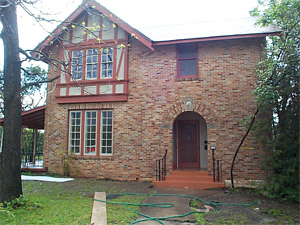Building and Remodeling History
Rudy Niño


When this English Tutor-style home was built in the early 1930s, it featured an eclectic mix of decorative style throughout.
According to its current owner, Linda Janney, the home included large amounts of wrought iron, Italian-style tile, nickel-plated hardware on the doors, cove-plaster ceilings, diamond-patterned windows and concrete medallions over the arched entry way.
So Janney, wanting to preserve as much of the original architecture, light fixtures and style as possible, hired SA Building and Remodeling Co. to remodel the 75-year-old home. The historic house, vacant for years, was in desperate need of an overhaul.
"This was a major restoration project," said Bryan Smith, SA Building's project supervisor for the home's restoration. "The house had been sitting unoccupied for a about six years, so there were a lot of problems from the beginning."
And there were a lot of problems indeed. Smith said the entire home had to be rewired, molded carpet removed, the roof repaired and rotten flooring replaced, amongst other things. Repairing the wood floor to its original state proved to be one of the more difficult tasks.
But before the work crew could get started, barricades were set up toward the rear of the home. The flooring, both upstairs and down, had been rotted out completely, making extra safety precautions necessary to ensure no one would fall through.
"There were several spaces that had been rotted out completely," Smith said. "We had to splice in aged, old wood flooring and refinish it all to make it look consistent with the era."
They had to do this because "wood is not as dense as it used to be," Smith explained. "It tends to have a lot of water retention so when it dries, it tends to take on a different dimension than the old wood, which is very difficult to match."
This was made possible by using wood from other homes of the same time period, which had recently been demolished.
"A lot of times when a home has been sitting for 70 years or longer, it collects oils and other things which can change the wood," Smith continued. "So it is very difficult to put new wood and old wood together and make it look consistent. But we were able to do it with wood from that period."
The $100,000 project, which took about six months to complete, also included extensive work on the interior walls of the home.
Since the home's wiring needed to be brought up to city code standards, the task of rewiring without damaging too much of the actual wall was a challenge for the crew.
"In order to bring the electrical up to code in the home, we had to break plaster off the walls throughout the whole house," said Rudy Nino of SA Building and Remodeling.
This was challenging because homes from this period were not built using drywall and studs, Nino added. Most of these homes used plaster to construct the walls, so blending new plaster with old plaster proved to be a more than difficult undertaking.
"With this type of work you have to make sure you have a good masonry craftsman," Nino explained. "Because when you trowel on the plaster, you have to make sure it blends in so when it is painted it has a seamless look."
Problems did not only arise from the actual home itself, but from people outside its walls.
"People would come into the house after work hours and take things even though we tried not to leave many valuable items behind," Nino said. "That was one of the major problems we had. It would then take two or three weeks to get the product replaced."
Due to the theft of some items intended for use in the home, Nino said the project ran about six weeks longer than intended. However, it was still completed within its allotted time.
Even with some bumps along the way, the project proved to be successful.
"It's always great to work on a project that has such a historical significance and to be able to restore it to the original luster it was originally intended to have," Smith said.
"We love working on old houses because a lot of people wreck them and try to make them too modern. They never have what the original architect had designed it to look like. So we try to bring in a lot of the modern conveniences, but still maintain the integrity of the original home design."
Some of the modern conveniences to work their way into this early 1930s home were central air conditioning, to make the home more energy efficient, and installing computer- and network-ready wiring. Most of the upgrades are unnoticeable, Smith said.
"Everything we did was to ensure that the original architecture and integrity of the home was kept," Smith said. "From the rounded ceilings to the original wood floors to the exterior, we wanted to make it look like what it always was."
Call Rudy Niño for a quote at (210) 723-2616 or Request an Estimate online.
Copyright 1997-2024 SA Building & Remodeling. All Rights Reserved.
P.O. Box 794, Blanco, Texas 78606 • (210) 723-2616
Serving San Antonio, Austin, and the Texas Hill Country.
P.O. Box 794, Blanco, Texas 78606 • (210) 723-2616
Serving San Antonio, Austin, and the Texas Hill Country.
CRoW Creative & Technical Web Design